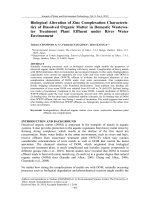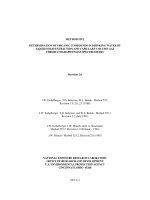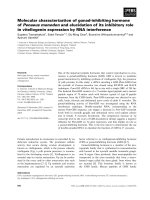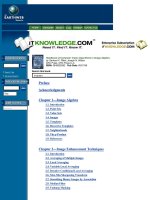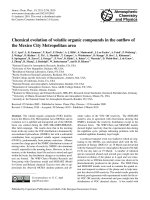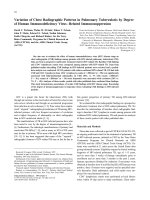Removal of endocrine disrupting compounds in municipal wastewater by membrane bioreactor (MBR) systems
Bạn đang xem bản rút gọn của tài liệu. Xem và tải ngay bản đầy đủ của tài liệu tại đây (1.59 MB, 238 trang )
i
REMOVAL OF ENDOCRINE DISRUPTING
COMPOUNDS IN MUNICIPLE WASTEWATER
BY MEMBRANE BIOREACTOR SYSTEMS
CHEN XIA
NATIONAL UNIVERSITY OF SINGAPORE
2009
ii
REMOVAL OF ENDOCRINE DISRUPTING
COMPOUNDS IN MUNICIPLE WASTEWATER
BY MEMBRANE BIOREACTOR SYSTEMS
CHEN XIA
(B. Eng., Tongji Univ.; M. Sc., Stuttgart Unv.)
A THESIS SUBMITTED
FOR THE DEGREE OF DOCTOR OF PHILOSOPHY
DEPARTMENT OF CIVIL ENGINEERING
NATIONAL UNIVERSITY OF SINGAPORE
2009
i
ACKNOWLEDGEMENT
The author wishes to express her deepest appreciation and gratitude to her supervisor,
Associate Professor Hu Jiangyong for her invaluable guidance and encouragement
throughout the entire course of the research project.
The author would also like to extend her sincere gratitude to all laboratory officers and
students, especially Mr. S.G. Chandrasegaran, Ms. Tan Xiaolan and Ms. Lee Leng Leng
at the Laboratory of Water Science & Technology at Division of Environmental Science
& Engineering, National University of Singapore, for their assistance and cooperation in
the many ways that made this research study possible.
Thanks are also due to the Bedok Wastewater Treatment Plant for the provision of
wastewater and sludge samples used in this study. The assistance and cooperation of the
staff there are greatly appreciated. Also, the authors would like to acknowledge Associate
Professor Ng How Yong, Mr. Tan Teck Wee and Ms. Tiew Siow Woon for their kind
assistance in providing the lab-scale MBRs and STPs samples. The author also
appreciates Prof. Chung Tai-Shung Neal at the Department of Chemical & Biomolecular
Engineering for me to use his equipment to analyze the contact angle of the activated
sludge.
The author would also like to extend her sincere gratitude to the Center for Advanced
Water Technology (CAWT), Public Utilities Board (PUB) Singapore for their financial
support on the pilot study.
ii
TABLE OF CONTENTS
Page
ACKNOWLEDGEMENT i
TABLE OF CONTENTS ii
SUMMARY viii
NOMENCLATURE xiii
LIST OF FIGURES xvii
LIST OF TABLES xx
LIST OF PLATES xxii
CHAPTER 1 INTRODUCTION 1
1.1 B
ACKGROUND 1
1.2 O
BJECTIVES AND SCOPE OF STUDY 5
CHAPTER 2 LITERATURE REVIEW 9
2.1 E
NDOCRINE DISRUPTING COMPOUNDS 9
2.1.1 General Comments 9
2.1.2 Classification of EDCs 10
2.1.2.1 Natural and Synthetic Steroid Hormones 10
2.1.2.2 Man-made Chemicals 14
2.1.2.3 Phytoestrogens 17
2.1.3 Affecting Mechanisms of EDCs to Organisms 19
2.1.4 Negative Influences of EDCs on Wildlife and Human Beings 20
2.1.5 Detection of EDCs 22
2.1.5.1 Chemical Analysis 22
iii
2.1.5.2 Biological Assays 25
2.1.6 Occurrence of EDCs in Sewage Treatment Plants Effluent 28
2.2 T
REATMENT OF EDCS IN SEWAGE TREATMENT PLANTS 30
2.2.1 General Comments 30
2.2.2 Elimination of EDCs during Biological Wastewater Treatment 30
2.2.2.1 Biodegradation of EDCs 30
2.2.2.2 Adsorption of EDCs to Activated Sludge 32
2.2.3 Formation of EDCs during Biological Wastewater Treatment 33
2.2.4 Potential Advanced Treatment Technologies in Removing EDCs in Aquatic
Environment 36
2.2.4.1 Removal by Activated Carbon 37
2.2.4.2 Removal by Oxidation Process 38
2.2.4.3 Removal by Membrane Filtration 38
2.2.4.4 Removal by Membrane Bioreactor 39
2.3 I
NFLUENCE OF OPERATION PARAMETERS ON EDCS REMOVAL 42
2.3.1 Influence of MLSS and Biomass Characteristics 42
2.3.2 Influence of Sludge Retention Time 43
2.3.3 Influence of pH 45
2.3.4 Influence of Initial Concentration of Substances 46
2.3.5 Influence of Anoxic Zone 47
2.3.6 Influence of Hydraulic Retention Time 47
2.4 M
EMBRANE BIOREACTORS FOR WASTEWATER TREATMENT 48
2.4.1 General Comments 48
2.4.2 Classification of Membrane Bioreactors 50
iv
2.4.2.1 MBR with external membrane filtration 51
2.4.2.2 MBR with internal, submerged membrane filtration 51
2.4.3 Anoxic-Aerobic Membrane Bioreactor Systems 53
2.5 C
URRENT STATUS AND RESEARCH NEEDS 54
CHAPTER 3 MATERIALS AND METHODS 64
3.1 I
NTRODUCTION 64
3.2 E
XPERIMENTAL SET-UP FOR ANAEROBIC SYSTEMS 64
3.3 E
XPERIMENTAL SET-UP FOR PILOT-SCALE STUDY 66
3.3.1 Set-up, Configuration and Operation of MBR Pilot Plants 66
3.3.2 Set-up of Complementary Lab-scale MBRs for Pilot-scale Study 68
3.4 E
XPERIMENTAL SET-UP FOR LAB-SCALE MBRS 70
3.4.1 Set-up, Configuration and Operation of Lab-scale MBRs 70
3.4.2 Batch Experiment for Lab-scale MBRs Performance Confirmation 73
3.5 E
XPERIMENTAL SET-UP FOR BATCH STUDY 74
3.5.1 Set-up of Degradation Test for EDCs and Conjugates 74
3.5.1.1 Activated Sludge Preparation 74
3.5.1.2 Degradation Test Procedure 75
3.5.2 Set-up of Adsorption Test for EDCs and Conjugates 76
3.5.2.1 Activated Sludge Preparation 76
3.5.2.2 Adsorption Test Procedure 76
3.6 S
AMPLE COLLECTION AND PREPARATION FOR PILOT AND LAB-SCALE MBRS 77
3.7 D
ETECTION OF EDC AND CONJUGATE COMPOUNDS-CHEMICAL ANALYSIS 78
3.7.1 Pre-treatment of Liquid Phase Samples 78
3.7.2 Pre-treatment of Solid Phase Samples 80
v
3.7.3 LC-MS-MS Analysis 82
3.8 D
ETECTION OF OVERALL ESTROGENICITY- YES BIOASSAY 83
3.8.1 Preparation of Standard Chemicals 84
3.8.2 Yeast Cultivation 85
3.8.3 YES Assay Procedure and Optimisation 86
3.8.4 Development of E2 Standard Curve 90
3.8.5 Statistical Analysis 91
3.9 M
EASUREMENT OF MBR SYSTEMS PERFORMANCE 92
3.9.1 Chemical Oxygen Demand 92
3.9.2 Nitrogen 92
3.9.3 Total Suspended Solids 92
3.9.4 Transmembrane Pressure 92
3.9.5 pH 93
3.10 M
EASUREMENT OF PHYSICOCHEMICAL CHARACTERISTICS OF ACTIVATED
SLUDGE 93
3.10.1 Mixed Liquor Suspended Solids & Mixed Liquor Volatile Suspended Solids
…………………………………………………………………………… 93
3.10.2 Extra cellular Polymeric Substance 93
3.10.3 Surface Charge 95
3.10.4 Hydrophobicity 96
3.10.5 Floc Size 97
3.11 M
EASUREMENT OF BIOLOGICAL CHARACTERISTICS OF ACTIVATED SLUDGE 97
3.11.1 Oxygen Uptake Rate and Specific Oxygen Uptake Rate 97
3.11.2 Non-flocculating Microorganisms 98
3.12 D
EGRADATION KINETICS 98
vi
3.13 A
DSORPTION ISOTHERM AND COEFFICIENTS 99
CHAPTER 4 RESULTS AND DISCUSSIONS 102
4.1 INTRODUCTION 102
4.2 R
EMOVAL OF EDCS IN MEMBRANE BIOREACTORS AND CONVENTIONAL SEWAGE
TREATMENT PROCESSES 103
4.2.1 Removal Efficiencies of EDCs in MBRs & STPs 103
4.2.2 Effect of HRT on EDCs Removal Efficiencies 109
4.2.3 Adsorption of EDCs by Sludge in MBRs & STPs 111
4.3 T
HE FATE OF EDCS IN PILOT-SCALE MBR SYSTEMS 113
4.3.1 Evaluation of Overall Estrogenicity in MBR Systems 113
4.3.2 Fate of Estrogen Compounds in MBR Systems 115
4.3.2.1 Fate of Hormones and Their Conjugates 115
4.3.2.2 Fate of Alkylphenols 122
4.3.3 Mass Balance Analysis 125
4.3.3.1. Pilot-Scale MBR Systems 126
4.3.3.2. Lab-scale MBR Systems 129
4.3.4 Comparison of Bioassay and Chemical Analysis 130
4.4 R
EMOVAL OF EDCS BY LAB-SCALE MBR SYSTEM 132
4.4.1 Overall Performance of MBRs 133
4.4.2 Physicochemical and Biological Characteristics of Activated sludge 135
4.4.2.1 Biomass Concentration 135
4.4.2.2 EPS 136
4.4.2.3 Floc Size 139
4.4.2.4 Surface Charge of Sludge 139
vii
4.4.2.5 Hydrophobicity of Sludge 141
4.4.2.6 OUR and SOUR of Sludge 142
4.4.2.7 Non-flocculating Microorganisms 144
4.4.3 Influence of SRT on the Removal of EDCs and Conjugates 145
4.4.4 Influence of Anoxic Zone on the Removal of EDCs and Conjugates 150
4.4.5 Further Batch Study for Confirmation of Lab-scale MBR Performance 151
4.4.5.1 Batch Results for Adsorption Performance 151
4.4.5.2 Batch Results for Removal Performance 156
4.5 D
EGRADATION AND ADSORPTION OF ESTROGENS AND CONJUGATES BY BATCH
STUDY 160
4.5.1 Degradation of Estrogens and Conjugates by Activated Sludge 160
4.5.1.1 Effect of Initial Concentration 160
4.5.1.2 Effect of MLSS 165
4.5.1.3 Metabolic Products 169
4.5.2 Adsorption of Estrogens and Conjugates by Activated Sludge 172
4.5.2.1 Adsorption of Natural Estrogens 172
4.5.2.2 Adsorption of Natural Estrogen Conjugates 181
4.5.2.3 Effect of Experimental Settings on Adsorption 183
CHAPTER 5 CONCLUSIONS AND RECOMMENDATIONS 187
5.1 C
ONCLUSIONS 187
5.2 R
ECOMMENDATIONS 190
References ……………………………………………………………………… 192
Publications ……………………………………………………………………….214
viii
SUMMARY
Environmental pollution with persistent chemicals becomes an increasingly important
issue worldwide. The main pathway of micropollutants into the environment was
identified as municipal wastewater. The extended use of chemicals in many product
formulations and insufficient wastewater treatment lead to an increase of the detected
micropollutant quantities in wastewater effluents. A large spectrum of pollutants present
in wastewater as traces has been reported to exert adverse effects for human and wildlife.
Even though compounds are found in wastewater with a very small amount, they may
have the undesirable estrogenic activity on various high forms of life.
Membrane Bioreactor (MBR) represents one of the most promising innovations in the
field of wastewater treatment because of its high efficiency in removal of organics and
nutrients. The high quality of the effluent is obtained by the complete retention of
suspended solids, the almost complete removal of pathogens, and the possibility to
increase biodegradation of micropollutants due to the higher sludge retention time (SRT)
in MBRs, in comparison to the conventional sewage treatment plants (STPs). The present
research focuses on the fate and removal of hydrophobic micropollutants in a MBR.
In this study, the fate and removal mechanisms of endocrine disrupting compounds
(EDCs) and the effect of opertaional parameters on EDCs and their conjugates removal
efficiency during wastewater treatment by pilot-scale and lab-scale MBRs, and batch
experiments were investigated. The detailed study includes the comparison of removal
ix
performance of estrone (E1), 17ß-estradiol (E2), 17α-ethinylestradiol (EE2), Bisphenol A
(BPA), 4-Nonylphenol (NP) and overall estrogenicity from municipal wastewater in
MBRs and STPs; examination of the fate of EDCs in anoxic-aerobic pilot MBR systems;
study of the elimination kinetics of EDCs, including biodegradation of EDCs, and de-
conjugation of EDC conjugates under different initial concentration and MLSS
concentration by batch study; study of the adsorption kinetics for EDCs and conjugates
under different pH value by batch study, and study of the influence of SRT, hydraulic
retention time (HRT) and anoxic zone on the elimination capacity of EDCs by lab-scale
MBR systems study.
First of all, MBR was verified to be a better choice to remove EDCs due to its long SRT,
high MLSS and so on, compared with STP. It is also evident that longer HRT can
improve the removal efficiency of E1, E2 and BPA. However, with the increase of HRT,
the removal of NP was lowered. Moreover, the adsorption of NP on biomass was
demonstrated to be the highest amongst all EDCs, and the adsorption of EDCs per kg
biomass was higher in STPs than that in MBRs.
To elucidate how the EDCs were removed in MBR more clearly, the fate of active and
potential EDCs (EDC conjugates) in 3 pilot-scale and 2 lab-scale MBR systems were
then conducted. Results showed that E1 was removed with relatively high efficiency
(80.2-91.4%), but E2 was removed with moderate efficiency (49.3-66.5%) by the MBRs.
However, the experimental results indicated that after the treatment by MBR, substantial
amounts of E1, E1-3S (estrone-3-sulfate), estrone-3-glucuronide (E1-3G) and 17β-
estradiol-glucuronide (E2-G) passed through the treatment systems and entered into the
x
aquatic environment. The reduction in the levels of overall equivalent E1 (68.4%) and
that of overall equivalent E2 (80.8%) was demonstrated for the pilot-scale MBR-B. For
alkylphenol compounds, BPA was removed well with a removal efficiency of 68.9-
90.1%. In contrast, NP concentration was amplified (removal efficiency of -439.5-
161.1%) after MBR treatment which could be caused by the transformation of its parent
compounds, nonylphenol polyethoxylates
(NPnEOs). The amounts of adsorbed estrogens
per kg dry mass was relatively low, due to short HRT and high MLSS in MBRs,
compared to that in STPs.
The removal of E1, E2 and their conjugates under different SRT (15, 30 and 45 d) by lab-
scale MBRs operated in parallel was assessed and compared. Estrogen glucuronides were
easily eliminated under all SRT. The removal efficiency of estrogen sulfates was the
highest at SRT of 45 d, but the lowest was at 30 d. It indicated that the removal of
estrogen sulfates benefited a lot from the increase of biomass and sludge hydrophobicity
by the increase of SRT. Also, it is clear that estrogen glucuronides were easier to be
degraded than estrogen sulfates. For natural estrogens, SRT did not affect E2 removal
significantly. In contrast, the removal of E1 was more complicated, because quite a big
amount of E1 could be formed when E2, E1-3G, E2-3G, E1-3S and E2-3S were degraded,
and the highest E1 removal efficiency was observed at SRT of 15 d. Moreover, the
influence of anoxic zone on EDCs removal was also studied. It is clear that the anoxic
zone could decrease the estrogens and their conjugates removal, due to the decrease of
biomass concentration in MBRs.
xi
In addition, it was found that the removal of E2 and its conjugates was strongly
dependent on their initial concentration and MLSS concentration. In the batch
experiments, all studied compounds were eliminated at higher rate at higher initial
concentration and MLSS concentration. The Michaelis-Menten Model satisfactorily
described the degradation of all compounds over the range of initial concentration and
MLSS concentration used. Also, the degradation rates sequence amongst EDCs was
found to be E2> E2-3G> E2-3S.
Furthermore, the adsorption isotherm of steroid estrogens and their conjugates by the
activated sludge was described by the Freundlich equation. Based on the results, it
appears that pH was an important parameter. The established Freundlich Model showed
the relatively low adsorption of E1 at pH 11.5 (K
F
= 0.05 mg
1-1/n
(m
3
)
1/n
g TSS
-1
), which
might be caused by the electrostatic repulsion. In contrast, the adsorption capacity of E2
was the highest at neutral pH (K
F
= 0.60 mg
1-1/n
(m
3
)
1/n
g TSS
-1
), but decreased while pH
decreased or increased, which might be attributed to the electrostatic repulsion and other
cations that might compete with E2 at the sorption sites.
For estrogen conjugates, the adsorption capacity of estrogen sulfates was reported here
for the first time. For both E1-3S and E2-3S, pH 5, 7 and 9 allowed for a comparable
adsorption performance, the adsorption capacity was the lowest (K
F
= 0.006 and 0.012
mg
1-1/n
(m
3
)
1/n
g TSS
-1
for E1-3S and E2-3S) at a pH of 11.5, which could be caused by
electrostatic repulsion, but was the highest (K
F
= 0.189 and 0.347 mg
1-1/n
(m
3
)
1/n
g TSS
-1
for E1-3S and E2-3S) at a pH of 2, which could be caused by the increase of sulfate
adsorbability.
xii
In the adsorption study, the specific adsorption coefficient K
D
, the distribution
coefficients normalized to the organic matter K
OM
and the organic carbon content K
OC
of
the adsorbent for estrogens and their conjugates were calculated. It was noted that the real
values for the above parameters to measure the adsorbability of estrogens and conjugates
would be slightly higher because of the experimental settings.
This study obtained a more in-depth understanding of EDCs removal in MBR systems.
With the in-depth understanding, MBRs can be operated with best EDCs removal
performance.
Keywords: Membrane Bioreactor (MBR), Endocrine Disrupting Compound (EDC),
Conjugate, Overall Estrogenicity, Adsorption, Degradation, Fate, Removal, Operational
Parameter.
xiii
NOMENCLATURE
AF
-
Anaerobic Filter
ANSBR
-
Anaerobic Sequencing Batch Reactor
APCI
-
Atmospheric Pressure Chemical Ionization
BNR
-
Biological Nutrient Removal
BPA
-
Bisphenol A
CF
-
Concentration Factor
COD
-
Chemical Oxygen Demand
DO
-
Dissolved Oxygen
E1
-
Estrone
E1-3G
-
Estrone-3-Glucuronide
E1-3S
-
Estrone-3-Sulfate
E2
-
17β-estradiol
E2-3G
-
17β-estradiol-3-Glucuronide
E2-3S
-
17β-estradiol-3-Sulfate
E2-Eq
-
17ß-estradiol equivalence
E3
-
Estriol
xiv
EDC
-
Endocrine Disrupting Compound
EE2
-
17α-ethinylestradiol
EEF
-
17ß-estradiol Equivalency Factor
EEQ
-
17ß-estradiol Equivalent Concentrations
EPS
-
Extra cellular Polymeric Substance
ER
-
Epoxy Resin
ERE
-
Estrogen Responsive Elements
ERCALUX
-
ER-mediated Chemically Activated Luciferase Gene
Expression
ESI
-
Electrospray Ionization
F/M
-
Food to Microorganism ratio
GC
-
Gas Chromatography
hER
-
human Estrogen Receptor α gene
HRT
-
Hydraulic Retention Time
K
D
-
Specific Adsorption Coefficient
K
OC
-
Organic Carbon Content Coefficient
K
OM
-
Organic Matter Coefficient
K
OW
-
Octanol-Water Partition Coefficient
xv
Kp
-
Sludge-water Partition Coefficient
LC
-
Liquid Chromatography
LLE
-
Liquid-Liquid Extraction
LOD
-
Limit of Detection
MF
-
Microfiltration
MLSS
-
Mixed Liquor Suspended Solids
MLVSS
-
Mixed Liquor Volatile Suspended Solids
MBR
-
Membrane Bioreactor
MS
-
Mass Spectrum
NF
-
Nanofiltration
NP
-
4-Nonylphenol
NPnEOs
-
Nonylphenol Polyethoxylates
OLR
-
Organic Loading Rate
ONPG
-
orthonitrophenol
OP
-
Octylphenol
OUR
-
Oxygen Uptake Rate
PC
-
Polycarbonate
PCBs
-
Polychlorinated biphenyls
xvi
PK
a
-
Acid Dissociation Constant
RO
-
Reverse Osmosis
RP
-
Reverse Phase
RR
-
Recirculation Ratio
SRT
-
Sludge Retention Time
STP
-
Sewage Treatment Plant
SOUR
-
Specific Oxygen Uptake Rate
TMP
-
Transmembrane Pressure
TN
-
Total Nitrogen
TSS
-
Total suspended solids
UASB
-
Upflow Anaerobic Sludge Blanket
UF
-
Ultrafiltration
YES
-
Yeast Estrogen Screen
xvii
LIST OF FIGURES
Page
Figure 1.1: Structure of This Study 8
Figure 2.1: Molecular Structure of Natural and Synthetic Steroid Hormones 13
Figure 2.2: Molecular Structure of BPA and NP 16
Figure 2.3: Most Common Phytoestrogens Found in Plants 18
Figure 2.4: Schematic Representation of Mechanisms of Action of (Anti-)estrogenic
Responses as Measured in Three In-vitro Bioassays. (a) Estrogen Receptor (ER)
Competitive Ligand Binding Assay, (b) a Yeast Estrogen Screen Assay in Stably
Transformed Yeast Cells, and (c) ER-mediated Chemically Activated Luciferase
Gene Expression in Stably Transfected T47D Human Breast Cancer Cells 26
Figure 2.5: De-conjugation of E2 into Biologically Active and Inactive Compounds 36
Figure 2.6: Schematic Representation of the MCASP with External (a) and Internal (b)
Membrane Filtration 52
Figure 2.7: Process Diagram of Aerobic-Anoxic MBR 54
Figure 3.1: Set-Up of Lab-Scale Anaerobic System Including Polishing Step (MBR and
STP) 65
Figure 3.2: Schematic Diagrams of Pilot-Scale MBR Systems 67
Figure 3.3: Schematic Diagram of a Pre-denitrification Submerged Lab-Scale MBR Used
in This Pilot Study 69
Figure 3.4: Schematic Diagram of Lab-Scale Aerobic MBR 70
Figure 3.5: Summary of EDCs SPE Procedures 79
Figure 3.6: Flow Chart of Sludge Samples Pretreatment Procedure 81
Figure 3.7: Yeast Receptor Gene Assay Mechanism 84
xviii
Figure 3.8: Summary of Yeast Cultivation Procedures 86
Figure 3.9: Summary of YES Assay Procedures. 87
Figure 3.10: Optimisation of YES Assay’s Reaction Time 89
Figure 3.11: E2 Standard Curve 90
Figure 4.1: Removal Efficiencies of EDCs by MBRs and STPs 105
Figure 4.2: Adsorption of EDCs in MBRs and STPs 112
Figure 4.3: Overcall Estrogenicity of Liquid Samples in Pilot- and Lab- Scale MBRs 114
Figure 4.4: Overall Estrogenicity in Sludge from the Anoxic and Aerobic Tanks of Pilot-
and Lab-Scale MBRs 115
Figure 4.5: Mass Balance Analysis of Pilot-Scale MBR Systems for Overall Estrogenicity
127
Figure 4.6: Mass Balance Analysis of Lab-Scale MBR Systems for Overall Estrogenicity
130
Figure 4.7: Variation of MLSS and MLVSS in Lab-Scale MBRs with SRT 136
Figure 4.8: EPS of Activated Sludge in MBRs 138
Figure 4.9: Surface Charge of Sludge in MBRs 140
Figure 4.10: Contact Angle of Sludge in MBRs 142
Figure 4.11: OUR and SOUR of Biomass in MBRs 143
Figure 4.12: Non-flocculating Microorganisms in MBRs 145
Figure 4.13: Removal Performance of EDCs and Their Conjugates by MBRs 147
Figure 4.14: Removal Performance of EDCs and Their Conjugates Per Gram MLVSS
.147
Figure 4.15: Concentration of (a) E1 and (b) E2 in Water after Adsorption in MBRs
Operated with Different SRTs 153
Figure 4.16: Concentration of (a) E1-3G and (b) E2-3G in Water after Adsorption in
MBRs Operated with Different SRTs 154
xix
Figure 4.17: Concentration of (a) E1-3S and (b) E2-3S in Water after Adsorption to
Sludge in MBRs Operated with Different SRT 155
Figure 4.18: Removal of (a) E1 and (b) E2 by Sludge in MBRs Operated with Different
SRT 157
Figure 4.19: Removal of (a) E1-3G and (b) E2-3G by Sludge in MBRs Operated with
Different SRT 158
Figure 4.20: Removal of (a) E1-3S and (b) E2-3S by Sludge in MBRs Operated with
Different SRT 159
Figure 4.21: Degradation of E2 and its Conjugates (E2-3G and E2-3S) under Different
Initial Concentrations 163
Figure 4.22: Degradation of E2 and Conjugates (E2-3G and E2-3S) under Different
MLSS Concentrations 167
Figure 4.23: The Metabolised Products of E2-3G and E2-3S with Initial Concentration of
50 µg/L at MLSS of 4 g/L 171
Figure 4.24: Adsorption Freundlich Isotherms of E1, E2, E1-3S and E2-3S by Inactivated
Sludge. 174
Figure 4.25: Relative Adsorbed Amount (%) of E1, E2, E1-3S and E2-3S to Inactivated
Sludge in Dependency on the pH at Initial Concentration of 50 µg/L. 177
Figure 4.26: Zeta Potential of Activated Sludge 179
xx
LIST OF TABLES
Page
Table 2.1: Properties of Natural and Synthetic Steroid Hormones……………………… 13
Table 2.2: Properties of BPA and NP…………………………………………………… 16
Table 2.3: A Summary of the Different Types of SPE Cartridges Commonly Used
…… …………………………………………………………………………24
Table 2.4: Concentration of EDCs in Effluents of Sewage Treatment Plants……… 29
Table 2.5: Elimination Efficiencies of Endocrine Disrupting Compounds by MBRs and
STPs in References……………………………………………………………… 41
Table 3.1: Overall View of Pilot-Scale MBR Systems (baseline conditions are in
bracket)……………………………………………………………………………. 67
Table 3.2: Membrane Characteristics of Lab-Scale MBRs…………………………… 69
Table 3.3: Overall View of aerobic and A-O Lab-Scale MBR Systems………… 71
Table 3.4: Composition of Synthetic Wastewater………………………………………. 72
Table 3.5: Recipe of pH Buffer Solution……………………………………………… 77
Table 3.6: Chemicals and Sequence Required to Prepare 10 mL of Assay Buffer… … 85
Table 4.1: Concentrations of EDCs in the Influent and Effluent of MBRs and
STPs………………………………………………………………………………. 104
Table 4.2: Concentrations and Removal Efficiency of Natural Estrogens and Conjugates
in MBR Systems……………………………………………………………….…. 119
Table 4.3: Removal of Overall Equivalent E1 and E2 in MBR Systems (Calculated
with Median Value)………………………………………………………… … 120
Table 4.4: Amount of Natural Estrogens and Conjugates Adsorbed to Sludge in MBR
Systems……………………………………………………………………… …. 122
xxi
Table 4.5: Estrogen Concentrations in the Influent and Effluent Samples with the
Calculated EEQ-E2 Determined by Multiplying the Concentration with the E2
Equivalency Factor (Relative Estrogenic Potency) for Each Compound and Addition
of the Single EEQ-E2 Value and Measured EEQ-E2 by YES Assay ……………132
Table 4.6: Removal Efficiency of COD, TN and NH
4
+
-N by MBRs……………… 134
Table 4.7: Mean Particle Size of Sludge Flocs………………………………………… 139
Table 4.8: Parameters of Michaelis-Menten Model for E2 and its Conjugates (E2-3G and
E2-3S) under Different Initial Concentrations…………………………….……… 164
Table 4.9: Parameters of Michaelis-Menten Model for E2 and its Conjugates (E2-3G and
E2-3S) under Different MLSS Concentrations…………………………………… 168
Table 4.10: Effect of pH on Isothermal Constants (K
F
[mg
1-1/n
(m
3
)
1/n
g TSS
-1
]and 1/n)
of Freundlich Model for the Investigated Substances………………………….….175
Table 4.11: Specific Adsorption Coefficient K
D
(L kg TSS
-1
), K
OM
(L kg VSS
-1
) and K
OC
(L kg OC
-1
) for the Investigated Substances……………………………………… 181
xxii
LIST OF PLATES
Page
Plate 3-1: Photo of Pilot-Scale MBR Plants. …………………………………….…… 67
Plate 3-2: Set-Up of Solid-Phase Extraction ……… …………………………… … 80
Plate 3-3: Set-Up of Soxlet Extraction Apparatus (left) and Rotary Evaporator (right) 82
Chapter One: Introduction
1
CHAPTER 1 INTRODUCTION
1.1 Background
Municipal wastewater is a complex mixture of natural and synthetic organic chemicals
and potentially contains thousands of compounds. Some of the synthetic organic
compounds that are common in treated wastewater have been shown in laboratory studies
to induce endocrine disrupting effects. These endocrine disrupting compounds (EDCs)
include natural hormones such as natural estrogens, e.g. 17β-estradiol (E2) and estrone
(E1) from urinary excretion; synthetic compounds used in medicine as contraceptives and
in some hormonal therapies, e.g. 17α-ethinylestradiol (EE2); chemical intermediate used
to make epoxy resins, polycarbonate plastics, flame retardants and dental sealants, i.e.
bisphenol A (BPA); degradation products of nonionic surfactants, e.g. nonylphenol (NP).
Effluents from sewage treatments plants (STPs) may be discharged into rivers with
estrogenic contaminants at levels sufficient to induce negative influence to living
organisms. EDCs could bring vitellogenin biosynthesis in male fish (Jobling et al., 1998).
Birds, reptiles and mammals in polluted areas also undergo alterations of endocrine–
reproductive systems, decreased fertility and growth, poor hatching/egg shell thinning
and abnormal thyroid function (Preziosi, 1998). Besides the above effects on animals,
suspected effects of EDCs on humans include malformations of newborns, undescended
testicles, abnormal sperm, low sperm counts, abnormal thyroid function, female breast
cancer, male testicular prostate cancer and other effects (Chilvers et al., 1984; Kimmel,

